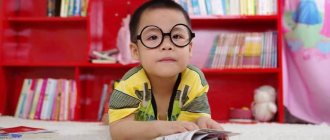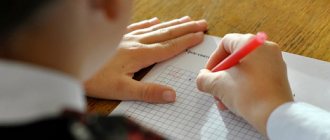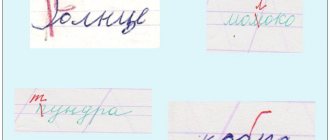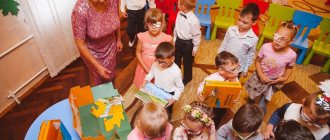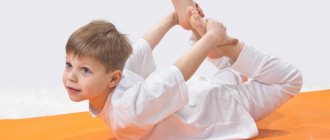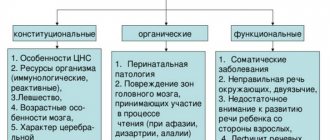What it is?
Neuropsychological correction (or, in short, neurocorrection) is a set of techniques that are used to overcome deviations and disorders in the development of mental functions in children aged 2 to 16 years. It is especially effective when working with children, who can be called:
- hyperactive, impulsive;
- excessively tired;
- awkward, sloppy, absent-minded;
- having difficulties in the areas of thinking, speech, spatial concepts, attention and memory;
- perform poorly at school due to problems with writing, reading, and arithmetic.
As is known, a child’s brain is formed throughout ontogenesis (his entire life). This process has its own order; it has a number of strictly defined stages. When these stages are disrupted for one reason or another (difficult childbirth, illness, developmental features, or adverse effects of the environment in which children grow up) are disrupted, the development of mental functions of the brain is also disrupted.
Some mental functions may be formed in a distorted form, or not formed at all. In such cases, the child is indicated for diagnosis and neurocorrection of mental functions and behavior.
Through a specially designed and selected set of motor and cognitive exercises, a neuropsychologist sequentially activates each zone of the child’s brain. These exercises - eye movements, joint movements of arms and legs, rocking, crawling - repeat the natural movements that a normally developing baby makes. When a child masters them, the structures of his brain finally begin to work in the sequence in which they should have been from the moment of birth.
In order for the method to bring results, all motor exercises must be performed carefully, in strict sequence and always in combination with cognitive exercises, individually and under the supervision of a specialist. Only then do they become the basis for the activation of higher mental functions - emotions, perception, attention, memory, thinking, self-regulation processes, etc.
Through control of his body and his movements, as well as through mastering cognitive functions, the child gets the opportunity to overcome maladaptive features of his development, difficulties in school learning, difficulties in self-regulation and childhood behavioral problems.
Neuropsychological sensorimotor correction
What is neurocorrection?
The method of neuropsychological sensorimotor correction was developed at the Department of Child Psychiatry and Psychotherapy of Medical Psychology of the Russian Medical Academy of Postgraduate Education (RMAPO) by Professor Yu.S.
Shevchenko and Ph.D. psychol. Sciences V.A. Korneeva. Neurocorrection is a set of correctional and developmental exercises that allows you to develop “problematic”, lagging brain functions that were identified during a neuropsychological examination.
More than 80% of children's developmental problems are associated with disorders and damage to the brain that arose in the early stages of development - during pregnancy, during childbirth, and as a result of serious illnesses in the first year of a child's life. Therefore, the impact of the method of neuropsychological sensorimotor correction is initially aimed not at the development of higher mental functions, but at the basal sensorimotor level, i.e. on the development of deficit functions that were damaged at an early stage of child development. And only in the final part of the correctional stage does the work move into the field of cognitive psychotherapy.
The goal of the method is continuous non-drug activation of subcortical and stem structures of the brain, stabilization of interhemispheric interaction, formation of the optimal functional status of the anterior structures of the brain.
The method consists of a series of breathing and motor exercises of gradually increasing complexity, leading to the activation of subcortical structures of the brain, promoting the regulation of tone, the removal of local muscle tension, the development of balance, the release of synkinesis, the development of the perception of the integrity of the body and the stabilization of static-kinetic balance. At the same time, the operational support of sensorimotor interaction with the outside world is restored, the processes of voluntary regulation and the meaning-forming function of psychomotor processes are stabilized, focused on the formation of the optimal functional status of the anterior lobes of the brain, on the development of thinking processes, attention and memory, synesthesia and self-regulation.
Children with autism have impaired perception of the world. The child avoids some sensations, but, on the contrary, strives for others, and they turn into autostimulation. In addition, signals received from different senses do not add up to a single picture. It is no coincidence that the symbol of autism is a disassembled puzzle. The main task of neuropsychological sensorimotor correction is to teach the child to be aware of himself in space, to improve the perception of the world around him, and to develop the child’s motor, cognitive and sensory skills.
Neuropsychological sensorimotor correction is one of the effective methods of helping children to overcome: decreased overall performance, increased fatigue, absent-mindedness; disturbance of mental activity; decreased function of attention and memory; unformed spatial representations; lack of self-regulation and control in the process of educational activities.
Restoring the balance between the sensory and motor spheres , as well as the development of both spheres, is the main result of neuropsychological sensorimotor correction. Only after the restoration of basic functions is further development of more complex ones (speech, thinking) possible.
Indications for neurocorrection
Neuropsychological correction is indicated for such types of diagnosis as:
- Childhood autism
- Mental retardation (mental retardation)
- SRD (speech development delay)
- Alalia, dysarthria
- ADHD (attention deficit hyperactivity disorder),
- Dyslexia, dysgraphia (writing and reading impairment)
- cerebral palsy
- Organic disorders
- Neurocorrection effectively helps with learning problems of various types
When should you start?
The most effective method is for children aged 5 to 12 years. The sooner the disorder is diagnosed and therapy begins, the faster its results will be visible. On average, the minimum effect is achieved after 2-3 months, the maximum after 7-9 months.
In the case of organic disorders, when the child’s development is very slow, the appearance of noticeable results of correctional work can take months and even years.
Forms
Corrective work can be carried out both individually and in group form.
Neurocorrection can be carried out in the form of play sessions, in the form of a set of motor exercises (sensorimotor correction), breathing exercises, exercises for the development of speech and articulation
Sensorimotor correction through motor and play exercises solves the following problems:
- The child learns to feel his body and the space around him.
- Visual-motor coordination develops (eye-hand, the ability to accurately direct movement - important when writing, and not only).
- The correct interaction of arms and legs is formed.
- Auditory and visual attention develops.
- The child learns to perform actions consistently, breaking them down into a number of tasks and other important things.
Stages
Diagnostic stage. The most adequate diagnostic method in this case is A. R. Luria’s technique, adapted for childhood. The advantage of neuropsychological diagnostics is that it can be used to identify not only the current level of knowledge and skills of the child, but also the basic pathogenic factors leading to the observed developmental disorders.
Installation stage. The goal of this stage is to create in the child and his parents an active attitude towards psychocorrectional work, the formation of motives for self-knowledge and self-improvement, reducing anxiety, and increasing confidence in the possibility of achieving positive changes. The need for the installation stage in this case is due to the fact that quite often the use of sensorimotor correction techniques does not meet the expectations of parents who “tune in” to the psychological techniques known to them, including suggestive ones. Thus, a more complete understanding of the problem and reformulation of the request occurs. To increase the effectiveness of correctional work, it is necessary to explain to parents and children (at a level accessible to them) the meaning of certain exercises performed by the child.
Corrective stage: corrective action is being implemented. Sensorimotor correction can be carried out both individually and in group form. The beginning of correctional work is aimed mainly at improving the functioning of subcortical structures, improving cerebral circulation, normalizing activation processes, relieving tonic disorders, and increasing performance. The next stage of correctional work is aimed at the development of the motor, spatial sphere, the formation of an adequate body diagram and image of the physical self, the development of fine motor skills; many exercises are carried out with the aim of increasing the differentiation of brain functional systems and improving interhemispheric interaction. The last stage is aimed at increasing the level of self-regulation and voluntary control. The order in which the child performs the exercises corresponds to the direction of ontogenetic development (starting from a lying position, then sitting, on all fours, standing). Indirectly, through optimizing the functioning of brain structures that regulate the functioning of internal organs, neurohumoral and immune systems, as well as through increasing the level of reflection and self-control, including in the sphere of physicality, the condition and somatic sphere of the child improves.
Evaluating the effectiveness of correctional work. It should be noted that the elimination of a symptom is not a sufficient reason to complete the corrective work. A positive result, expressed in the elimination of manifestations of maladjustment and previously existing violations, is not the only criterion of effectiveness. Relieving symptoms and overcoming maladaptation may be temporary. If the causative factors are not eliminated, then a rapid return of the same or other symptoms is quite possible. Many parents consider the ultimate goal to be the removal of the violations that were the reason for contacting a specialist. However, classes with the child must be continued to destroy the pathological mechanism, ensure the sustainability of the achieved effect, and prevent new disorders. It is necessary to take into account that this method has a whole range of indirect results: for example, increasing self-esteem, self-confidence, overcoming difficulties in communication. The maximum effect is achieved 7-9 months after the end of psychocorrection. A delayed check should show the sustainability of the achieved results at long-term stages after completion of the correction. To take into account the effectiveness, it is advisable to carry out diagnostics using the same techniques that were used before the start of correction. In addition, the specificity of sensorimotor correction makes it possible to use objective criteria for improving the child’s condition - data from a medical examination and clinical studies (EEG, RheoEG, etc.). Despite the stability of the results of sensorimotor correction, it is possible to repeat the correction course. This is not due to the leveling of the effects of the work done, but to the dynamism of mental ontogenesis, changes in the social situation of development, as well as the impact of various negative factors (injuries, diseases, etc.).
Thus, the process of neuropsychological sensorimotor correction is aimed at the most complete adaptation of an autistic child to life in society, at integration from special into other types of educational institutions.
Sources:
https://neirokid.ru/stati/article_post/neyropsikhologicheskaya-korrektsiya-pri-autizme
https://logoped-ryazan.ru/neyropsikholog/principal_and_methods_nerocorectcia.php
Method components
Neuropsychological diagnostics and behavior correction in childhood are conventionally divided into two inextricably linked components:
- Motor correction;
- Cognitive or educational correction.
The first component, already described above, serves to stimulate the regulation of movements, improve interhemispheric interaction and the development of children’s spatial representations.
The second component, cognitive correction, is aimed at developing cognitive skills and overcoming the child’s learning difficulties.
To create stable and positive motivation in a child, neurocorrection classes are conducted in a playful way.
The course of motor correction includes at least 25 lessons. One lesson lasts from 40 to 60 minutes, depending on age. Make an appointment Addresses and telephone numbers of branches in Moscow Ask a question Reviews
Who does a pediatric neuropsychologist work with?
Recently, classes with this specialist for children have become especially relevant. Brain disorders occur due to various reasons, in particular:
- birth injuries;
- fetal hypoxia during pregnancy;
- traumatic brain injuries;
- effects of anesthesia;
- severe illnesses in early childhood.
In addition, unfortunately, the changed social conditions in which modern children grow up have a great influence. Replacing “live” communication with computer communication, reducing the volume of gaming activities, the culture of yard games and spending time with older children, ensuring a logical transfer of skills and knowledge from older to younger.
Sessions with a neuropsychologist are recommended in the presence of many disorders:
- Attention deficit hyperactivity disorder.
- Delayed mental and (or) speech development.
- Mental disorders on the autism spectrum.
- History of perinatal encephalopathy.
- Stuttering (logoneurosis).
- Speech development disorders.
- Dyslexia or dysgraphia.
- Problems with learning at school.
How does a neuropsychologist work?
Correction methods in neuropsychologist classes mainly include some physical and intellectual exercises. Therapy is carried out without the use of medications.
It is obligatory to examine the child at the initial stage of classes. Diagnostics does not require hardware tests; it is completely safe for the child. Children are offered various tasks - complete a drawing, remember the sequence of objects, words, put together a picture, etc.
Among other things, the peculiarities of the course of pregnancy, childbirth and child development are clarified. Based on these data, the specialist draws conclusions about the cause of the existing violations and proposes a plan for corrective training.
The duration of the work depends on the complexity of the problem, the age of the child (as you know, the earlier a violation is noticed, the easier it is to correct it) and other factors. Sometimes assignments are given to complete at home.

